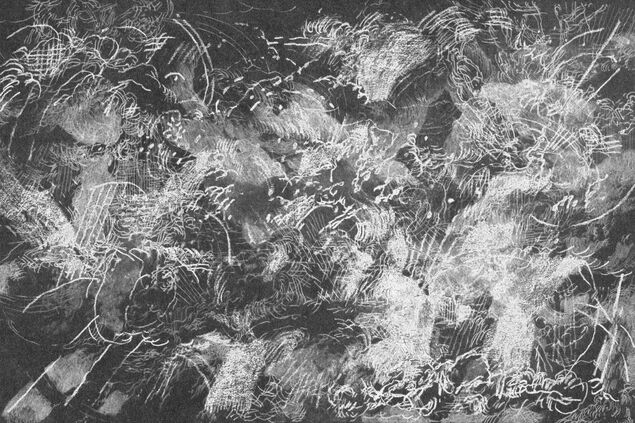An expansion of the universe of Pierre Boulez in a concert dedicated to the centenary of the great French composer and conductor.
Boulez–100
- Date:
- 23 Oct 2025,
20:00–21:30
- Age restrictions
- 12+
Programme
Pierre Boulez (1925–2016)
Anthèmes 2, 1997
for violin and live electronics
Sur Incises, 1996–1998 (first performance in Russia)
for three pianos, three harps and three percussionists
Performed by
Fyodor Lednev conductor
Daniil Kogan violin
Boulez Ensemble
Yuri Favorin piano
Nikolai Mazhara piano
Maria Sadurdinova piano
Luisa Mintsaeva harp
Anastasia Alferova harp
Evgenia Marchenko harp
Alexander Suvorov percussion
Philipp Fitin percussion
Evsevy Zubkov percussion

Illustration: Anastasia Filippova
Most of Boulez’s mature compositions are built on this principle, including Sur Incises (1996–1998). The printed score of the composer’s last large-scale work ends with a blank page, graphically emphasising the openness of the form, and the piece emerged from Incises (“Incisions”), a shorter work for piano, which Boulez wrote in 1994 and which he originally conceived as a fragment of something larger. Boulez said himself that only three-quarters of the ideas that he had in mind found a place in the published version of the original piano miniature. In Sur Incises (“On Incisions”) he realised those ideas more fully by expanding the instrumentation: an ensemble of three grand pianos, three harps, and percussion combine into a grandiose “super-instrument”, which explores the three basic elements of piano sound—strike, vibration, and resonance. The extreme density of the musical fabric, the diversity of timbre and the sophisticated detail of the texture work together in Sur Incises to generate what a writer on Boulez’s music has called “organised delirium”.
The composer himself explained: “It became apparent to me, in the course of my own evolution, that I had an increasingly manifest tendency to abolish the border between the incomplete and the finished, and that my orientation towards the use of directed randomness reflected a rejection of total determination. Is this a certain form of modernity, or just being of our time, which can be found elsewhere, in other modes of expression? Is it a desire to give a proper chance to what is random, or rather what is unexpected, compared to which any stop looks like an artifice? Is it simply indecision in the face of the improbability of the ‘masterpiece’, which is necessarily closed, and even closed off in its autonomy? Ultimately, is it not rather a desire to assert that the real work, defined by spatial and temporal limits, could only be, in a way, a more or less voluntary fragment of a great imaginary, virtual work, whose origin and end we would prefer not to know?”
In his later years, Boulez, in a stylistic shift that is surprising for the post-war European avant-garde, revived the idioms of Romantic instrumental writing. This is a theme that links Sur Incises with the piece Anthèmes 2, which was written at around the same time (in 1997). Anthèmes 2, like Sur Incises, has a primary source also by Boulez—the solo violin miniature Anthèmes, which was first performed in 1991. Six years later, the composer orchestrated his text for violin and live electronics, making virtuoso use of the possibilities of spatial audio: the sound source is not localised on the podium but seems to arise spontaneously from different points in the hall, generating a truly theatrical effect. The solo voice expands into a virtual choir, whence the title of the work, which refers to the style of English Baroque vocal music, characterised by an alternation of solo and choral episodes.
Fyodor Lednev (b. 1971, Minsk) is a conductor. He graduated from the Saint Petersburg Conservatory specialising in choral conducting (1995) and operatic and symphonic conducting (1998). Since 1995, he has taught at the Saint Petersburg Rimsky-Korsakov Music College. He has appeared as guest conductor with leading Russian orchestras, including the Svetlanov State Orchestra, the Russian National Orchestra, the Russian National Youth Symphony Orchestra, the musicAeterna Choir and Orchestra, and others. In 2024 he won the prize for Best Conducting Work at the Golden Mask theatre awards in Moscow.
Daniil Kogan (b. 1993, Moscow) is a violinist. He studied with Maya Glezarova at the Moscow Conservatory, continuing his studies at the Maastricht Conservatory with Boris Belkin and with Eduard Wulfson in Geneva. He was a prize winner at the Long-Thibaud-Crespin International Piano and Violin Competition (Paris, 2018), the Viktor Tretyakov International Violin Competition (Krasnoyarsk), and the 17th International Tchaikovsky Competition (Moscow, 2023). Since 2019, he has been the artistic director of Pritiazheniye Creative Association. Daniil Kogan teaches at the Moscow Conservatory.

